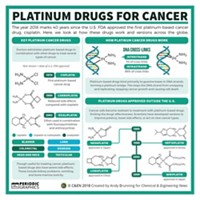Advertisement
Grab your lab coat. Let's get started
Welcome!
Welcome!
Create an account below to get 6 C&EN articles per month, receive newsletters and more - all free.
It seems this is your first time logging in online. Please enter the following information to continue.
As an ACS member you automatically get access to this site. All we need is few more details to create your reading experience.
Not you? Sign in with a different account.
Not you? Sign in with a different account.
ERROR 1
ERROR 1
ERROR 2
ERROR 2
ERROR 2
ERROR 2
ERROR 2
Password and Confirm password must match.
If you have an ACS member number, please enter it here so we can link this account to your membership. (optional)
ERROR 2
ACS values your privacy. By submitting your information, you are gaining access to C&EN and subscribing to our weekly newsletter. We use the information you provide to make your reading experience better, and we will never sell your data to third party members.
Synthesis
Another Take On Platinum Cancer Drugs
July 26, 2010
| A version of this story appeared in
Volume 88, Issue 30
The recent article “Platinum Drugs Take Their Toll” summarized the lack of success in bringing new platinum anticancer drugs to the clinic (C&EN, June 28, page 24). Although the process to advance or terminate a new drug candidate is quite complex, a few points concerning drug discovery in the platinum world are worth noting.
Forty years ago, Professor Barnett Rosenberg, the discoverer of the anticancer properties of cisplatin, roughly outlined the structure-activity relationships (SARs)for Pt(II) and Pt(IV) compounds and suggested that cisplatin may kill cells by forming an intrastrand purine dimer on DNA. The ability of active platinum structures to form this type of DNA adduct caused drug discovery to be almost exclusively focused on cis platinum structures capable of forming the proper intrastrand cross-link with DNA, and the successes and failures mentioned in the article are largely the result of this kind of thinking.
Although changing long-standing paradigms in science has never been easy, research within the past few years has shown that structures having the trans geometry and some compounds that appear incapable of binding to DNA are quite active in killing cancer cells. It is intriguing to think that if the so-called rule breakers—agents that do not conform to the perceived SAR—had an early share in the drug discovery process, there would be more of these remarkable drugs available for treating cancer today. Certainly, more and potentially better platinum agents are yet to be discovered. But the real question is, Do academia, industry, and government have energy remaining to pursue discovery in a field that is considered by some to have already matured?
James C. Dabrowiak
Syracuse, N.Y.



Join the conversation
Contact the reporter
Submit a Letter to the Editor for publication
Engage with us on Twitter